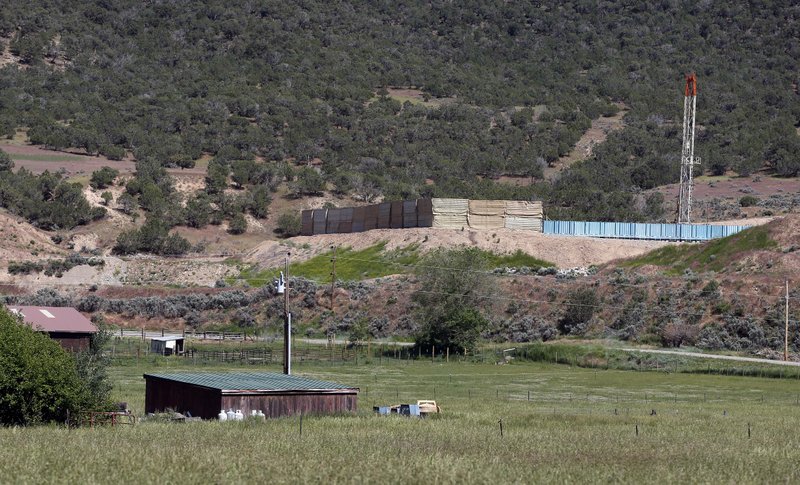NEW CASTLE, Colo. -- Four in 10 new oil and gas wells near national forests and fragile watersheds -- or otherwise identified as higher pollution risks -- escape federal inspection, according to a review that shows wide state-by-state disparities in safety checks.
Roughly half or more of the wells on federal and Indian lands weren't checked in Colorado, Utah and Wyoming, despite potential harm that has led to efforts in some communities to ban new drilling.
In New Castle, a tiny Colorado River valley community, homeowners were frustrated by the large number of uninspected wells that dot the steep hillsides and rocky landscape. Like elsewhere in the West, water is a precious commodity in the Colorado town.
"Nobody wants to live by an oil rig," said Joann Jaramillo, 54.
About 250 yards up the hill from Jaramillo's home, on land that was a dormant gravel pit when she bought the house eight years ago, is an active drilling operation that operates every day from 7 a.m. until sometimes 10:30 p.m. Jaramillo said the drilling began about three years ago.
Even if the wells were inspected, she questioned whether that would ensure their safety. She said many view the oil and gas industry as self-policing and nontransparent.
"Who are they going to report to?" she asked.
Government data point to the Bureau of Land Management being so overwhelmed by a boom in a drilling technique known as hydraulic fracturing, or fracking, that it has been unable to keep up with inspections of some of the highest-priority wells. That's an agency designation based on a greater need to protect against possible water contamination and other environmental and safety issues.
Factors also include whether the well is near a high-pressure formation or whether the drill operator lacks a clear track record of service.
"No one would have predicted the incredible boom of drilling on federal lands and the number of wells we've been asked to process," said the Bureau of Land Management's deputy director, Linda Lance.
Since 2009, about 90 percent of new wells on federal land have been drilled by fracking, which involves pumping huge volumes of water, sand and chemicals underground.
"The current rate of inspections is simply not acceptable to us," Lance said.
The agency oversees 100,000 oil and gas wells on public lands, 3,486 of which received the high-priority designation.
According to bureau records for fiscal 2009 to 2012, 1,400 of those high-priority wells, spread across 13 states, were not federally inspected. Wyoming had the most, 632, or 45 percent. South Dakota had 1 out of 2 wells uninspected, and Pennsylvania had 1 out of 6.
All the higher-risk wells were inspected in six states -- Alabama, Michigan, Mississippi, New York, Ohio and Texas.
Many more wells are located on private lands, where state officials take the lead in ensuring they comply with environmental laws, with mixed results. Nationwide, there were nearly 500,000 producing gas wells in 2012, according to Energy Information Administration data. More than 1,800 new wells were being drilled in March alone.
Dennis Willis, a former Bureau of Land Management field officer in Price, Utah, said he routinely provided input on oil leasing and drilling decisions on federal land before his retirement in 2009.
He described a situation of chronic underfunding dating to at least the early 2000s, when bureau management made clear that issuing new permits would be a priority over other tasks, according to a 2002 memorandum from supervisors in Utah to field officers. At the time, fracking was becoming more widely used.
"There certainly wasn't a shortage of spills, leaks, pipeline failures and other problems," said Willis, who now does consulting work for conservation and other groups. "It's a disaster waiting to happen."
Lance said Bureau of Land Management field managers are making judgment calls to minimize the risk of potential harm to surrounding communities. The agency also is reviewing whether it needs to slow down the pace of permits to ensure public safety.
Officials noted that money provided by Congress for oil and gas operations has declined since 2007. During that period, the number of wells drilled on federal and Indian lands has increased by roughly one-third.
"We're trying to do the best we can with limited resources," Lance said.
If approved by Congress, the Bureau of Land Management's 2015 budget request of $150 million for oil and gas operations would allow the agency to conduct the bulk of its required inspections over three years, in part by collecting fees from oil and gas companies. Unlike past years, $48 million will be earmarked for inspections. The bureau made similar budget requests the past several years with little success.
Information for this article was contributed by Michelle Price and Kevin Begos of The Associated Press.
A Section on 06/15/2014
